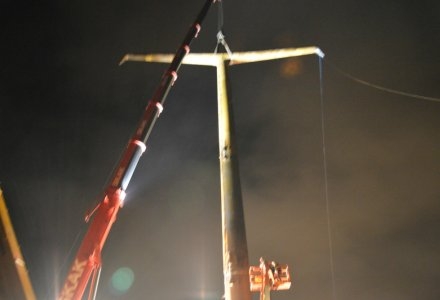The winner of a UK competition aimed at developing a new generation of electricity pylons, the T-Pylon is shorter, lighter and simpler than existing lattice designs and could, claim its developers, help meet the expected demand for large numbers of new pylons.

Developed over a period of 11 months by National Grid, Bystrup, and Danish steel firm DS SM the pylon was successfully erected by a team of four on its pre-installed monopile foundation. According to National Grid, this compares favourably, in terms of construction man hours, to today’s lattice pylons.
Made from uncoated steel, the pylo’s weathered appearance has been likened to the Angel of the North sculpture, and the design team is so pleased with the look that is now said to be considering using weathering steel (e.g. Corten), with the final design.
According to a National Grid blog on the project, one of the main lessons learned form the installation process was that the cast iron cast connections between the crossarm to the horn and crossarm to the mast, via the heart at the top of the pylon, are challenging and time-consuming to put together on site.
The heart (five tonnes) and horns (one tonne for the pair) are made from cast iron and so are heavy that the hundred or so nuts and bolts which join them are each the length of a forearm, and need to be tightened to a specific torque which can only be achieved in a tight space with a torque converter.
The team is now said to be considering having the crossarm, heart and horns pre-assembled in the factory. They could then be taken to site as two sections, saving a considerable amount of time. It is also looking at redesigning the cast elements with a different iron type and having threaded holes, which would remove the need for nuts, thus saving material and weight.
The team now plans to subject the pylon to a series of tests, including static load tests to simulate climatic and security loads; dynamic tests which will help the team understand the natural frequency of the structure; and damping tests.





Red Bull makes hydrogen fuel cell play with AVL
Formula 1 is an anachronistic anomaly where its only cutting edge is in engine development. The rules prohibit any real innovation and there would be...